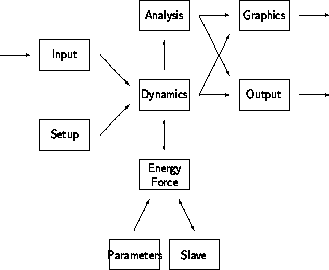

The initialization of the simulation is made by loading data from a previous simulation through the input module or by generation of a new configuration in the setup module.
The total-energy method used as the basis for the simulation is implemented in the energy module. The parameters are loaded from a database.
Alternatively, the total energy method may be presented to the simulation program in the form of a slave program. The simulation module contains a spectrum of methods for numerical solution of the equation of motion.
As simulations may consume enormous computational resources it is important that the program provides an analysis module for use while the simulation is in progress. The analysis module should contain a monitor and facilities for a basic analysis of the results. While the analysis module provides a preliminary analysis of the results, the monitor provides a detailled analysis of the simulation algorithm.
The output from a simulation program is primarily data for further analysis by other programs. The data may also form the starting point for further simulations.
Images and graphs stored during the simulation may also be an efficient way of reviewing the simulations. It is convenient to review the progress of extended simulations by replaying the stored images as animations every few hours while the simulation is in progress.